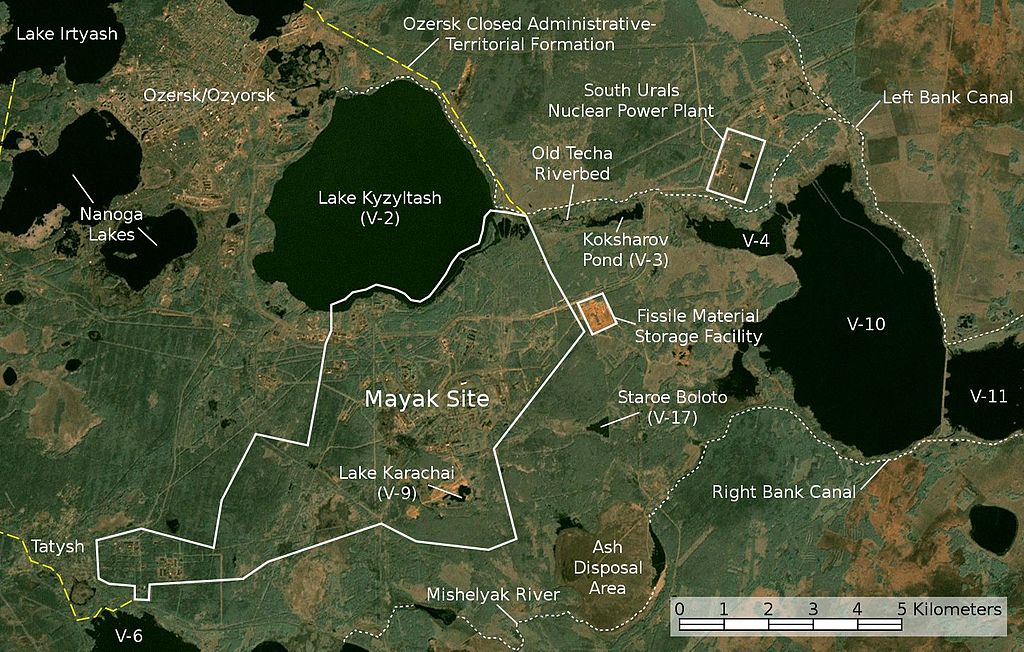by Tatyana Ivanova
An international scandal involving ruthenium-106 (Ru-106) contamination of the atmosphere in most European countries has revealed fundamental problems with the Russian nuclear industry. The Russian State Corporation (Rosatom) has denied the massive leak at its Ural reprocessing facility. Instead, it has withheld data and spread propaganda in the best Soviet tradition.
During the last two months, Western European countries have been trying to identify the source of the Ru-106 cloud, which according to the French IRSN drifted over a majority of European countries. Several European networks involved in the monitoring of atmospheric radioactive contamination detected Ru-106 in late September. Then, German and French nuclear regulators found traces in the atmosphere at low but not dangerous levels. Later, 36 countries reported their measurements of Ru-106 to the International Atomic Energy Agency (IAEA).
The countries were puzzled by the source of contamination. Such a large-scale spread of a man-made radionuclide—not routinely detected in the atmosphere—could indicate a serious accident at a nuclear facility. The IAEA’s Incident and Emergency Centre (IEC) therefore asked European member states to share information about “any recent events associated with an atmospheric release of Ru-106.” Member states reported their own measurements of Ru-106, but none of the countries (including Russia) reported an incident. The agency said that the contamination did not pose a danger, because of the low concentrations of Ru-106.
The agency nevertheless detailed the kinds of situations that do not cause such a leak. The lack of other fission products accompanying the Ru-106 precludes the possibility of an accident at a nuclear reactor or spent nuclear fuel storage. The IEC also said that relatively small amounts of Ru-106 used in cancer treatment are unlikely to cause the reported air concentration. Also, Ru-106 can be used in a satellite as a source for a radioisotope thermoelectric generator (RTG). However such usage is not common, and no satellite containing Ru-106 has fallen back to earth during this period.
There are not many options left. Experts say that one of two kinds of events could cause such contamination. IRSN concluded that the origin of the mysterious Ru-106 is to be found either in nuclear fuel cycle facilities or in radioactive source production. There are very few such facilities in the world.
Since the IAEA didn’t find the source of contamination, the French IRSN and later the Ukrainian nuclear regulator carried out their own investigations.
Russian Traces
The results of independent modeling carried out by the IRSN and the Ukrainian regulator—based on the aggregated Ru-106 pollution data and meteorological conditions—indicate that the release zone lies “between the Volga and the Urals.” IRSN also calculated its total activity, which was considerable – between 100 and 300 TBq.
The Russian meteorological agency (Roshydromet), which monitors radioactive environmental pollution, then corroborated these findings. It also revealed measurements of “extremely high levels” of Ru-106 air contamination at two Russian villages in the Urals: Argayash and Novogorny. The levels were about 400 and 900 times higher then usual.
In this region of the Southern Urals, about 30 kilometers from these two polluted sites, there is only one potential large-scale polluter: the “Mayak” nuclear waste reprocessing plant. Accordingly, suspicion has fallen on it. Mayak is part of the Russian Rosatom State Corporation and is located at the closed secret town of Ozersk, in the Chelyabinsk district.
The source of the Ru-106 release could be facility number 235, which vitrifies highly radioactive waste. The same accident, according to the IAEA, occurred in 2001 in a similar nuclear fuel reprocessing plant at La Hague in northern France. A new vitrification furnace—the SverdNIIkhimmash EP-500/5—was put into operation in plant number 235 at Mayak at the end of December 2016.
According to Edwin Lyman of the Union of Concerned Scientists, the vitrification process oxidizes high-level waste solutions before they’re added to the glass melter. This tends to convert ruthenium into the tetroxide state, which is volatile. Reducing agents are added to prevent tetroxide formation. Lyman hypothesizes that an insufficient quantity of reducing agent added to a particular batch could result in the accidental production of ruthenium tetroxide, which would exceed the capacity of the off-gas filters. “Gaseous ruthenium tetroxide would then condense into small aerosol particles that could be transported large distances,” he concludes.
Rashid Alimov, from Greenpeace Russia, points out that the Russian furnace EP-500/5 has a special ruthenium tetroxide filter, which could fail. He notes that, according Rosatom’s 2015 annual report, Mayak routinely emits ruthenium tetroxide, but the recent release was significantly larger and exceeded the annual limit.
If such a large scale release had happened in France, IRSN reports, inhabitants within a radius of several kilometers would have been evacuated and local food produced within tens of kilometers would have been declared unsafe for human consumption.
Greenpeace Russia has already appealed to the Russian prosecutor’s office to investigate this accident. But “to date, everything points to Mayak,” says Alimov.
Nadezhda Kutepova, a Russian human rights defender from Ozersk who is now a political refugee in France, added that an accident with the vitrification furnace is probable because of a number of problems that occurred during its installation and testing.
Denial, Pressure, and Propaganda
As soon as information about the likely Russian origin of the ruthenium cloud over Europe appeared in the mass media, the Russian nuclear state corporation sprang into action to prevent any Russian investigation. Rosatom and then Mayak stated that their facilities couldn’t be a source of Ru-106 release and that the background radiation around them is normal. At the same time, they didn’t provide any specific data on Ru-106 concentrations in the air. Rosatom only made reference to its website, which is monitoring the gamma background.
A Russian regulatory agency “inspected” Mayak, and after only one day came to the hasty conclusion that there had been no accidents or events at the plant. Its public report contained only one number: the Ru-106 concentration in Bucharest that the IAEA had already published.
Some days later Russian pro-government mass media published a flurry of propaganda, denying that the contamination was of Russian origin and making fun of the journalists and citizens who wrote of a cover-up. Some of the Russian mass media disseminated false information that the release could have been caused by a downed American spy satellite or even an alien spaceship.
The most radical websites started a second wave of defamation against Nadezhda Kutepova, blaming her for espionage and intentional misinformation about Mayak. Some Russian officials blamed IRSN for issuing “false information” about the Russian trace, saying that the French regulator is competing with Rosatom.
Rosatom went further by publishing a poster on behalf of Ru-106 with the headline “Everyone accuses the little one” in the style of a propaganda cartoon for children. The poster states that Ru-106 is “small and good” and does not appear at nuclear waste reprocessing plants. Then the official Rosatom Facebook page invited journalists and bloggers to visit Mayak to “touch and smell” Ruthenium-106. They selected 16 people from 200 who expressed interest, stating that experts were not invited because they “already understand all the fictitiousness of the hype.”
At the same time, the Russian regulatory agency altered its published report, removing the words “extremely high concentrations of Ru-106” in reference to the villages around Mayak and reported instead that the levels did not exceed the limits. Last week a special commission including representatives of all the aforementioned Russian state organizations began another inspection of Mayak. The results have not yet been announced.
The situation is reminiscent of the Chernobyl catastrophe of 1986, during the Soviet era. Indeed, the Mayak facility, which specializes in nuclear fuel reprocessing and the production of nuclear weapons materials, never really left the Soviet era. The enterprise avoids publishing any detailed figures on emissions In its environmental impact assessments. An iron veil of secrecy, as well as Rosatom’s influence over decision-makers at the highest level, protect it from the scrutiny of Russians and everybody else.
Tatyana Ivanova is a Belarusian journalist residing in the United States. Photo: Satellite map of Mayak site (Wikimedia Commons).





